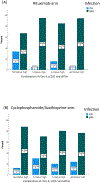Association of baseline soluble immune checkpoints with the risk of relapse in PR3-ANCA vasculitis following induction of remission
- PMID: 35973802
- PMCID: PMC12341842
- DOI: 10.1136/ard-2022-222479
Association of baseline soluble immune checkpoints with the risk of relapse in PR3-ANCA vasculitis following induction of remission
Abstract
Objectives: We investigated whether soluble immune checkpoints (sICPs) predict treatment resistance, relapse and infections in patients with antineutrophil cytoplasm antibody (ANCA)-associated vasculitis (AAV).
Methods: Plasma sICP concentrations from available samples obtained during conduct of the RAVE trial were measured by immunoabsorbent assays from patients with either proteinase 3 (PR3) or myeloperoxidase (MPO)-ANCA vasculitis and were correlated with clinical outcomes, a set of biomarkers and available flow cytometry analyses focusing on T cell subsets. Log-rank test was used to evaluate survival benefits, and optimal cut-off values of the marker molecules were calculated using Yeldons J.
Results: Analysis of 189 plasma samples at baseline revealed higher concentrations of sTim-3, sCD27, sLag-3, sPD-1 and sPD-L2 in patients with MPO-ANCA vasculitis (n=62) as compared with PR3-ANCA vasculitis (n=127). Among patients receiving rituximab induction therapy (n=95), the combination of lower soluble (s)Lag-3 (<90 pg/mL) and higher sCD27 (>3000 pg/mL) predicted therapy failure. Twenty-four out of 73 patients (32.9%) in the rituximab arm reaching remission at 6 months relapsed during follow-up. In this subgroup, high baseline values of sTim-3 (>1200 pg/mL), sCD27 (>1250 pg/mL) and sBTLA (>1000 pg/mL) were associated with both sustained remission and infectious complications. These findings could not be replicated in 94 patients randomised to receive cyclophosphamide/azathioprine.
Conclusions: Patients with AAV treated with rituximab achieved remission less frequently when concentrations of sLag-3 were low and concentrations of sCD27 were high. Higher concentrations of sTim-3, sCD27 and sBTLA at baseline predicted relapse in patients treated with rituximab. These results require confirmation but may contribute to a personalised treatment approach of AAV.
Keywords: autoimmune diseases; rituximab; systemic vasculitis.
© Author(s) (or their employer(s)) 2023. No commercial re-use. See rights and permissions. Published by BMJ.
Conflict of interest statement
Competing interests: None declared.
Figures




Similar articles
-
Antineutrophil cytoplasmic antibodies in infective endocarditis: a case report and systematic review of the literature.Clin Rheumatol. 2022 Oct;41(10):2949-2960. doi: 10.1007/s10067-022-06240-w. Epub 2022 Jun 23. Clin Rheumatol. 2022. PMID: 35732985 Free PMC article.
-
The plasma proteome reveals distinct signaling pathways associated with PR3-ANCA positive and MPO-ANCA positive vasculitis.Front Immunol. 2025 Jun 18;16:1600754. doi: 10.3389/fimmu.2025.1600754. eCollection 2025. Front Immunol. 2025. PMID: 40607391 Free PMC article.
-
Treatment for hepatitis C virus-associated mixed cryoglobulinaemia.Cochrane Database Syst Rev. 2018 May 7;5(5):CD011403. doi: 10.1002/14651858.CD011403.pub2. Cochrane Database Syst Rev. 2018. PMID: 29734473 Free PMC article.
-
Performance of MPO-ANCA and PR3-ANCA immunoassays for the stratification of specific ANCA-associated vasculitis: A systematic review and meta-analysis.Autoimmun Rev. 2022 Jun;21(6):103100. doi: 10.1016/j.autrev.2022.103100. Epub 2022 Apr 19. Autoimmun Rev. 2022. PMID: 35452854
-
Verification, implementation and harmonization of automated chemiluminescent immunoassays for MPO- and PR3-ANCA detection.Clin Chem Lab Med. 2023 Oct 24;62(4):682-689. doi: 10.1515/cclm-2023-0764. Print 2024 Mar 25. Clin Chem Lab Med. 2023. PMID: 37870064
Cited by
-
Advances in the treatment of ANCA-associated vasculitis.Nat Rev Rheumatol. 2025 Jul;21(7):396-413. doi: 10.1038/s41584-025-01266-1. Epub 2025 Jun 5. Nat Rev Rheumatol. 2025. PMID: 40473820 Review.
-
ANCA-Associated Glomerulonephritis: Diagnosis and Therapy Proceedings of the Henry Shavelle Lectureship.Glomerular Dis. 2024 Dec 2;5(1):26-47. doi: 10.1159/000542925. eCollection 2025 Jan-Dec. Glomerular Dis. 2024. PMID: 39991195 Free PMC article.
-
Targeting immune checkpoints in anti-neutrophil cytoplasmic antibodies associated vasculitis: the potential therapeutic targets in the future.Front Immunol. 2023 Apr 6;14:1156212. doi: 10.3389/fimmu.2023.1156212. eCollection 2023. Front Immunol. 2023. PMID: 37090741 Free PMC article. Review.
-
Immune checkpoint molecules performance in ANCA vasculitis.RMD Open. 2024 Nov 13;10(4):e004660. doi: 10.1136/rmdopen-2024-004660. RMD Open. 2024. PMID: 39537557 Free PMC article.
-
Association between Loss of Immune Checkpoint Programmed Cell Death Protein 1 and Active ANCA-Associated Renal Vasculitis.Int J Mol Sci. 2023 Feb 3;24(3):2975. doi: 10.3390/ijms24032975. Int J Mol Sci. 2023. PMID: 36769297 Free PMC article.
References
Publication types
MeSH terms
Substances
Grants and funding
LinkOut - more resources
Full Text Sources
Research Materials
Miscellaneous

